Tilda Swinton
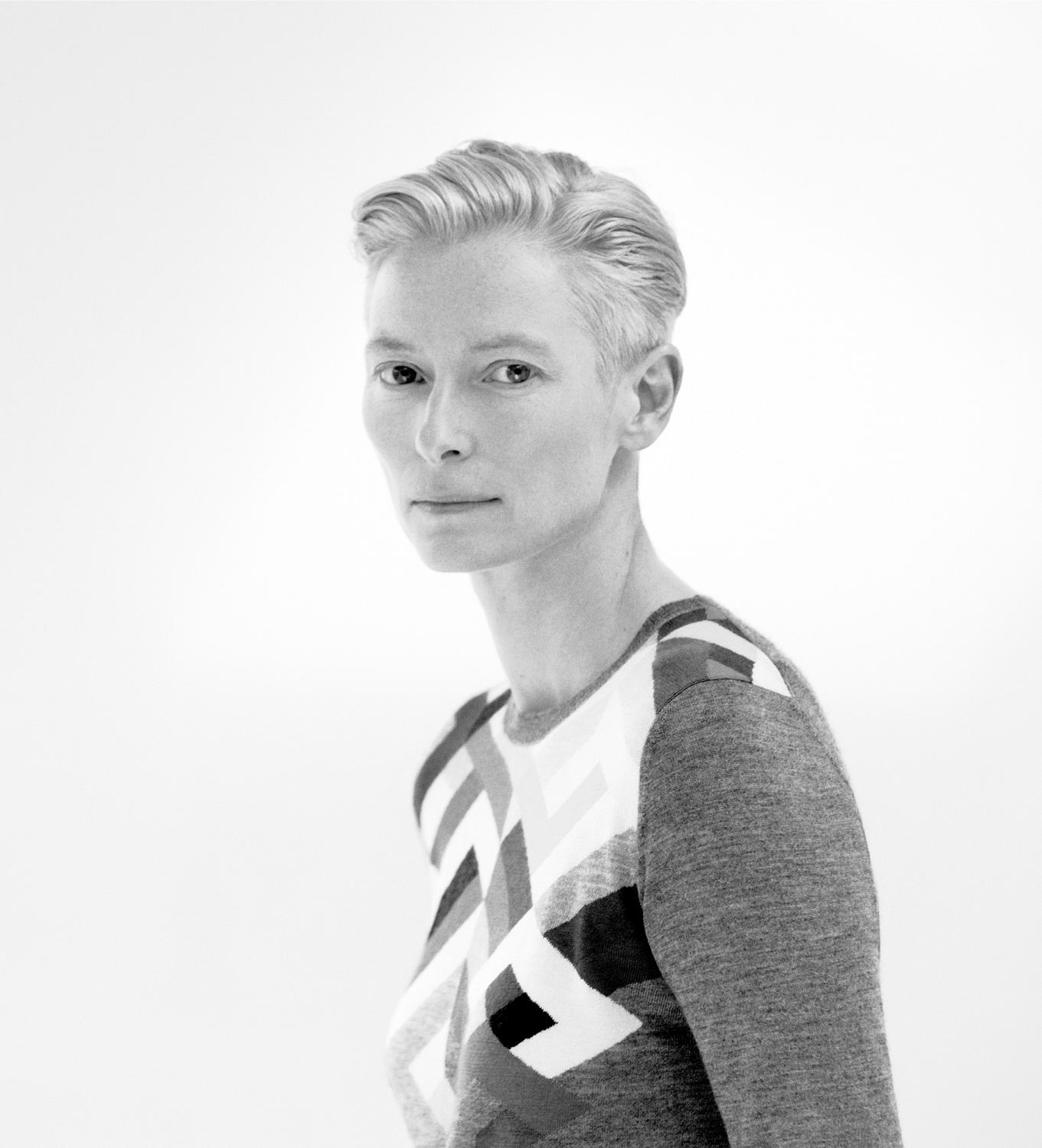
Portraits by Benjamin Alexander Huseby
Styling by Jonathan Kaye
Issue n° 5, Spring & Summer 2012
The next time you see Tilda Swinton, it will be in Wes Anderson’s Moonrise Kingdom, a story of love and revelation set in 1960s New England. And if the phenomenal, Oscar-winning Scottish actress has her way, it may be her last movie for quite a while.
Tilda, 51, has made 24 films in the last 15 years and crossed over from art-house icon to world-famous box-office draw. But she’s a firm believer in the fresh start. In 1997, she upped sticks for the spectacular natural surroundings of the Scottish Highlands, where she still lives. And this year she’s taking a breather to enjoy her enviable Arts and Crafts home and dream up the next adventure.
Tilda Swinton must be an expert at entertaining. There seems to be a steady flow of guests who make the pilgrimage to her home in the fishing port of Nairn, in the northeast fringe of the Scottish Highlands, where she lives with her artist boyfriend, Sandro Kopp, and her teenage twins, Xavier and Honor. The gossipy taxi driver who picks me up from the tiny airport in Inverness – the nearest to Nairn – one brisk November afternoon says I’ve missed Viktor & Rolf by only a couple of days. The Dutch fashion designers have been friends with the Oscar-winning actress since she performed in their Tilda-themed catwalk show in 2003. And just a few weeks before their visit, Brad Pitt took time off from filming in Glasgow to pay his Burn After Reading co-star a house call (Angelina came too). So when Tilda draws up at my hotel in an aged Land Rover full of springer spaniels, wearing a corduroy hacking jacket, cotton breeches, swathes of muslin scarf and a very tall pair of wellington boots, it should come as no surprise that she has a fun day out in store.
“Oh, good, you’re wearing trainers,” she says, gesturing with one arm for me to clamber into the front seat while she restrains an eager puppy with the other.
“I haven’t checked the tides, but it’s a fan-tas-tic day. I thought we could go down the beach for a walk.” The beach is the magnificent Culbin Sands, a vast strip of unspoiled shoreline along the Moray Firth. Extremely flat with the tide out, the Sands is a designated Site of Special Scientific Interest and an important nature reserve owned by Britain’s Royal Society for the Protection of Birds. Eider ducks, common scoters and ringed plovers are all ‘star species’ now at risk along this silvery coastline.
It’s this image of her native land that Tilda takes around the world with her when she’s shooting and promoting her feature films – she’s appeared in 47 to date. “To me, this beach is a bit like Africa. Now, are you up to a bit of a jump?” she says, leaping across a burn that winds down to the sea. “One of my favourite writers is Robert Louis Stevenson, and he was always doing this thing that I’m guilty of. That’s standing on an outcrop in New Zealand or wherever and saying, ‘Oh, it’s wonderful! It’s just like Scotland!’ And the local New Zealander, of course, is terribly offended.”
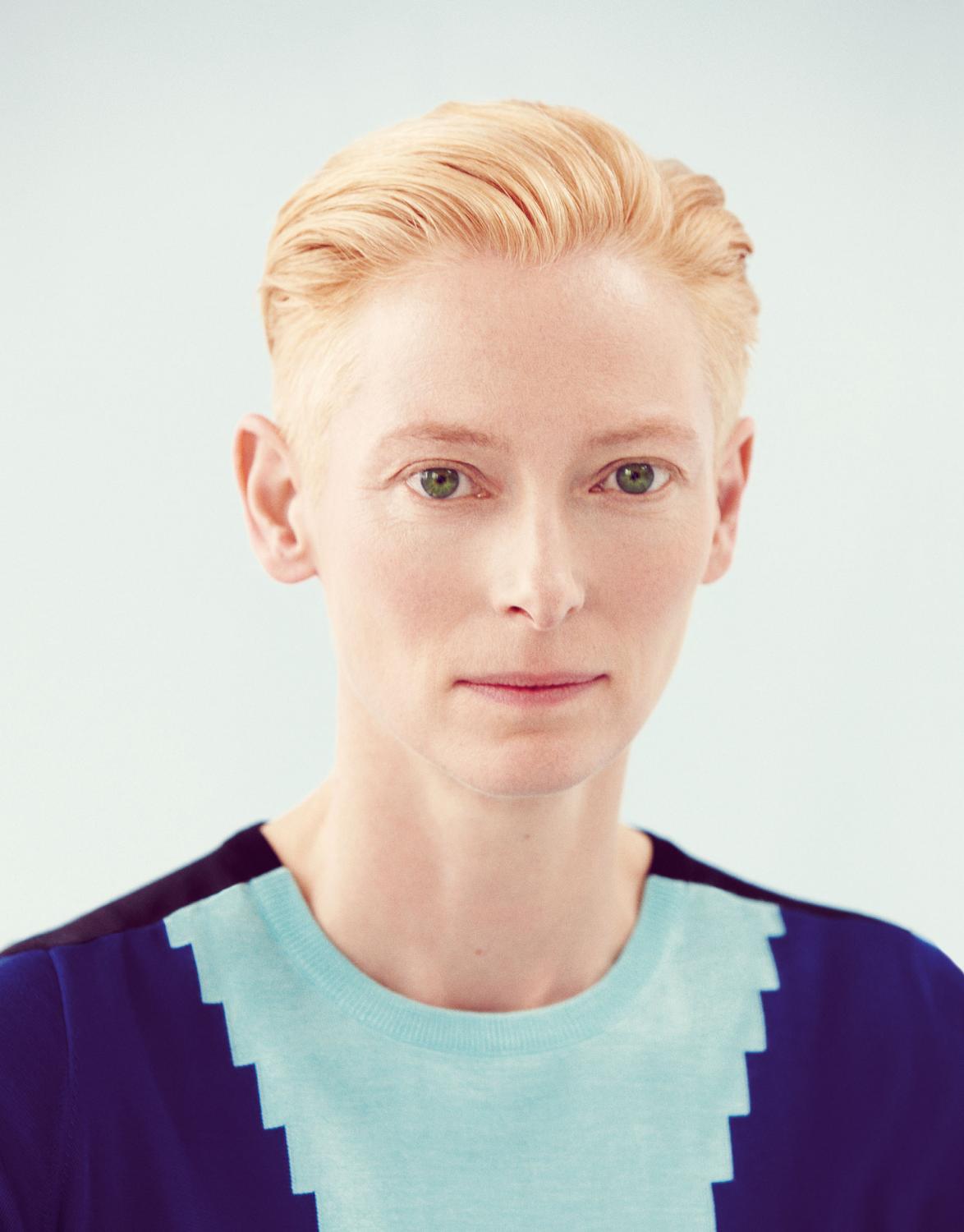
For the last three years, Tilda Swinton has been the ambassador for PRINGLE OF SCOTLAND, the Scottish luxury fashion knitwear company whose cropped-back, three-quarter-length-sleeve top she wears here.
Katherine Mathilda Swinton grew up many miles south of here, in the hilly, rural Borders region, where Scotland meets England and where her family can be traced back to the 11th century and earlier. Awarded their name by King Malcolm III, apparently for bravely seeing off the wild boar that roamed the land, Clan Swinton’s crest bears the image of a boar tethered to a tree. Their family motto is “J’èspère – je pense.” Tilda’s parents still live there, in the baronial Kimmerghame House, which they inherited when their only daughter was 13. But her father was a major general in the British Army, and his regular secondments to Germany and London made for a peripatetic family life for Tilda and her three brothers. “It was a chaotic environment. I can thank my parents for that – I think it really taught me the value of an easy house.”
Not that all the early upheaval encouraged her to stay put at Kimmerghame and marry a nobleman. Tilda attended three different schools in London and Edinburgh, then studied social and political sciences at Cambridge University. There, her enthusiastic participation in experimental theatre led to acceptance into the Royal Shakespeare Company in Stratford and then the Traverse Theatre Company in Edinburgh. In 1984, she finally settled in London, and the following year, she struck up her famous collaboration with the artist, filmmaker and gay activist Derek Jarman, whom she met at a casting for his 1986 masterpiece Caravaggio. Jarman was instantly enthralled by Tilda, according to the film’s production designer, Christopher Hobbs. “For the first time, Derek found in front of his camera a natural film star,” he said in 2003, “someone the camera absolutely adored. She was very poised; she came from a rather grand background, so she knew how. She was bored with being a deb and so did all these parts where she dressed with a moustache and rags.” Jarman went on to cast her in six more of his films, including the incendiary The Last of England (1988), Edward II (1991) and Blue (1993), for which she provided one of the voices. She was often at Prospect Cottage, Jarman’s hideaway in Dungeness on the Kent coast, and the pair were constant companions until his death from AIDS-related illness in 1994.
“The advantage of being here is that friends come, and they stay. We don’t just have dinner and then not see each other for four months.”
By then, Tilda was romantically involved with the Scottish artist and playwright John Byrne. The two had become lovers in 1989, when he cast her in Your Cheatin’ Heart, Byrne’s marvellous TV drama about the Glaswegian country and western scene. In the 1990s, her lessening ties to London spurred them into a drawn-out process of returning to Scotland. “It’s always embarrassing for me that we didn’t leave earlier, until John and I had the babies in 1997,” she says. “I’d been in the city during such a distinctive time, from the mid-’80s to the mid-’90s, and then suddenly things changed so fast. Many of my friends died, and there was a change in atmosphere.” After attending many funerals in 1994, the following year, Tilda staged ‘The Maybe’, her performance art collaboration with Cornelia Parker, at London’s Serpentine Gallery. In it, she spent a week on public view, eight hours a day, apparently asleep in a glass box. “By the time we left, there was a sort of scalded feeling. London was a place to get out of.”
Tilda and John took their new family to the Highlands to start a life where freedom and independence would be the priority. “Here,” she says now, gesturing towards the sand dunes and the huge pine forest, “I’m in the very luxurious position of choosing from a great menu each day: ‘What do we want? Do we want a bit of beach? Do we want a bit of wood? River and ravine?’ Every morning, I make up my mind what I’m going to do, and I’m not going to get distracted.”
She’s attentive company, certainly, and a brilliant conversationalist. As her family motto says, this 51-year-old likes to think. She also loves to talk – and it’s fun watching her deliver her immaculate sentences. Arriving at any word that particularly delights or horrifies her, Tilda widens those emerald eyes and cranes forward to stretch out every inch of her long, anglicised vowels. Striding through the wood, we cover all manner of subjects, from the recent change in the UK laws of succession – “I’m absolutely in support of women benefitting from anything men can, but frankly, I’m not into an-y-one benefiting from unearned income” – to her theory about the increasing rate of post-partum suicide among older mothers. She and her friend Tina, a local midwife, came up with this when Tilda was researching her most recent role as the shell-shocked new mother Eva Khatchadourian in We Need to Talk About Kevin (2011). “The cat-a-clysm of being the mother of a young baby is so hard when you’re older,” she says. “When you’re at a stage in life where you’re perceived to be in control. Tina was telling me she has all these young mothers of 18, 19, who are materially in more straitened circumstances, but more often they’re supported by a family network that the older mothers are not.”
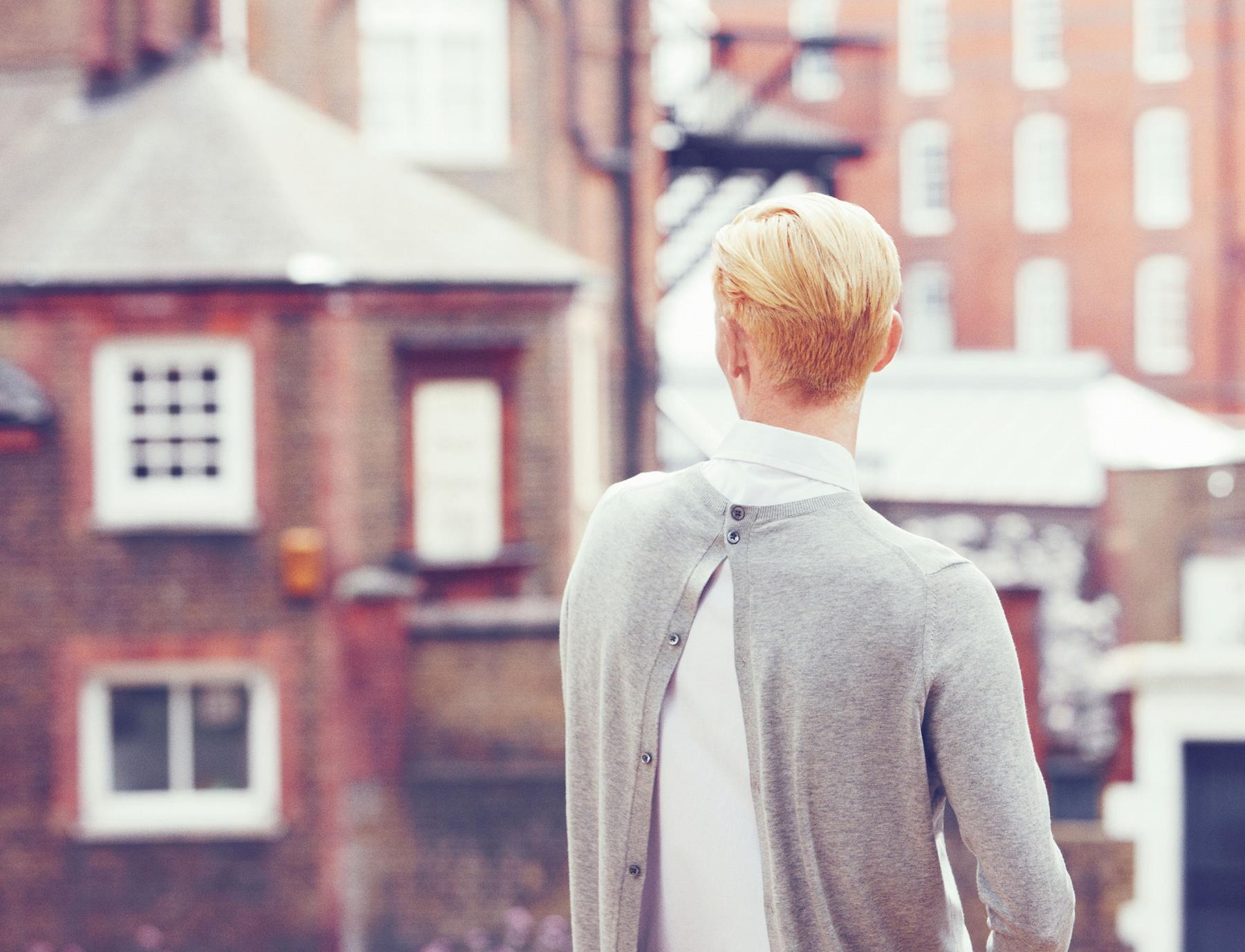
Photographed at Arnold Circus in east London, Tilda is wearing a long-sleeved cashmere sweater with reverse button fastening and a white shirt by PRINGLE OF SCOTLAND.
Tilda will gamely tackle any topic put to her, cheering on questions with long mmm, mmmm!s. Stopping briefly to chat to a local woman about the similarities of their dogs’ markings, she then starts on the outrageous cost of living in the south. “The truth of it is we couldn’t afford to live in London – I’m curious, how can anybody?” One would imagine she’s pretty wealthy, I venture. “One would imagine. One would imagine. One would imagine all sorts of things.”
Indeed, in February 2008, the Daily Mail most certainly did. The newspaper published a lurid piece alleging that Swinton, Byrne and Kopp were in a ménage à trois, cosying up together under the same roof in Nairn. Tilda responded in the press later that year, saying she and Byrne had split up five years before, when she’d met Kopp during the filming of The Chronicles of Narnia: The Lion, the Witch and the Wardrobe in 2004, and that their relationship had Byrne’s blessing. In the face of persistent insinuation, even Byrne felt forced to clarify matters further in The Times in 2009, saying he’d been miscast as some “benign eccentric who’s living there while some guy’s shagging his sweetheart.” Byrne has since kept a house across the road from Tilda’s to maintain contact with the twins, but he mainly lives in Edinburgh with his partner. As Tilda says, it’s all pretty regular stuff.
Had the right-leaning Mail bothered to look into her politics, it could have been appalled by those too. She was once a card-carrying member of the now-defunct Communist Party of Great Britain, and she solemnly states that politics is the last thing she’d like to be imprecise about. “The first time I could vote, Margaret Thatcher got in for an eternity, and we all had to become really active. Then, of course, the great tragedy of (former Labour leader) John Smith’s death was that the first time those of us on the left were able to prevail, we voted for Tony Blair, in ’97, who shafted us so royally. My fantasy is that Smith would have said something very different to George Bush. I think the whole idea of conventional politics is something my generation now has to really chew on. And I’m not there yet.”
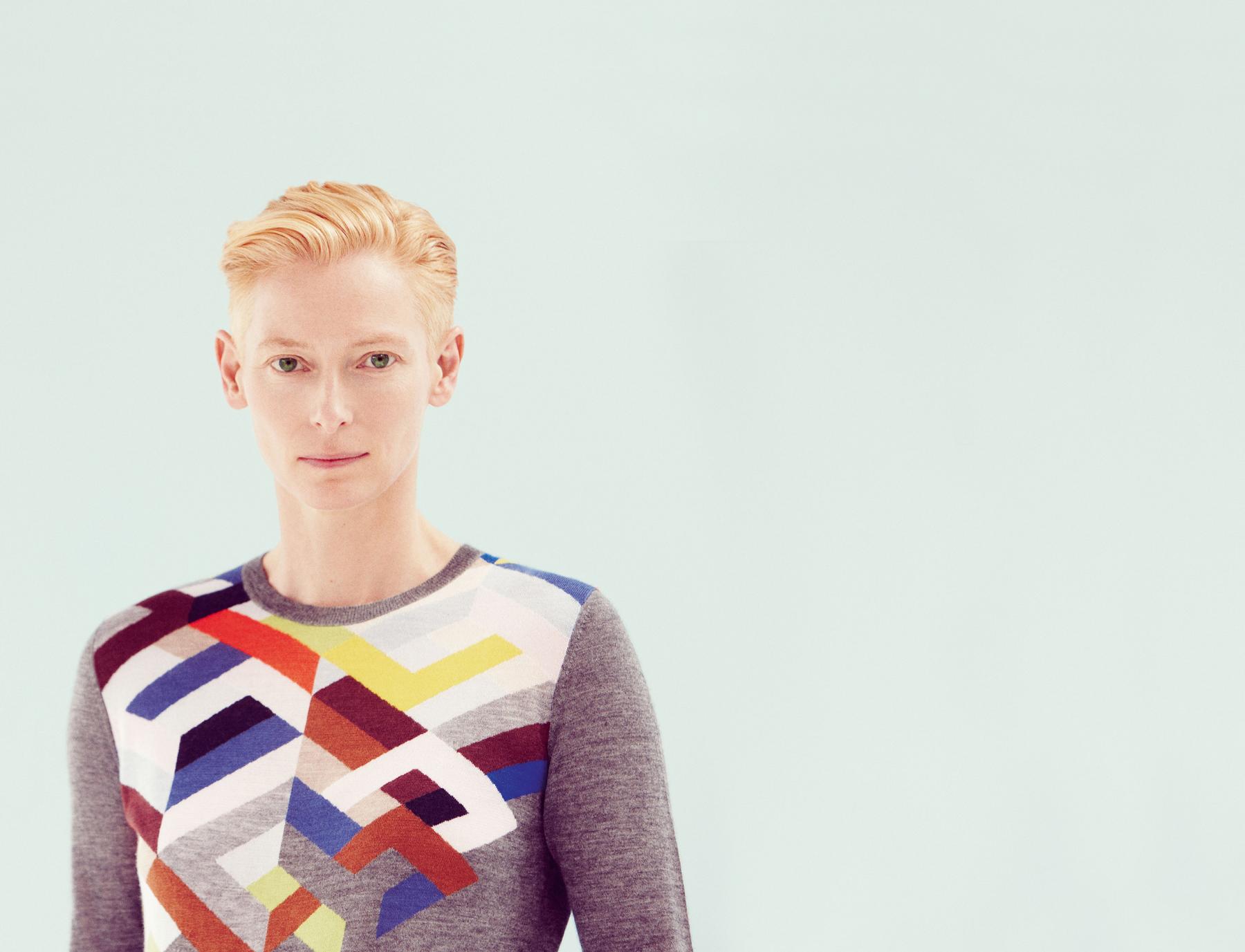
Here and in the opening image, Tilda is wearing a jolly cashmere silk, hand intarsia, long-sleeved sweater by PRINGLE OF SCOTLAND.
There’s more than one way to skin a cat, though, as Tilda puts it. Over the past five years, the avid Nairnshire Telegraph reader has been concentrating on local projects between her international acting commitments and her ambassadorial work for the brand Pringle of Scotland, which she represents at fashion- and art-related events all over the world. “Would you like to see the doorway to the Ballerina Ballroom?” she asks once we’re back in the Land Rover. She’s referring to the disused bingo hall where she staged a film festival in 2008, one year after winning her Oscar for Best Supporting Actress in Michael Clayton. In the 1960s, the Who, Cream and Pink Floyd played there. Four decades on, for an entry fee of £2 or £3 or a donation of home-baking, locals were treated to films chosen by Tilda and the former Edinburgh International Film Festival director Mark Cousins. “My first impetus was that Nairn needed a cinema,” she explains. “We’re dependent on the Vue in Inverness, where we can only see Harry Potter around the clock.” The programme included entertainment staples like Singin’ in the Rain and the camp classic The Bitter Tears of Petra von Kant. It wasn’t all community harmony, though. “Do you see these people here?” she says, jabbing her finger at the house next door. “They wouldn’t agree to allow people to exit onto their drive. Even in the event of a fire!”
Charlie Chaplin used to holiday in Nairn, Tilda tells me, and Margaret Rutherford, a favourite actress of hers, recovered from a broken heart in the hotel on the seafront. Maybe they benefited from the same respectful distance locals seem to keep from the world-famous movie star Tilda, even in this close-knit town with its population of eight and a half thousand. “It’s a question of the deal you make,” she says. “Every time someone kindly invites me to open a fête here, I politely decline, as I don’t want to emphasise whatever reason I may have been invited. I’d rather people knew me for buying vegetables in their greengrocer’s.” She says she’s recently joined the Culbin Singers, a community choir that meets at St. Leonard’s church in nearby Forres on Tuesday nights. “I think it’s pretty well known that we have some sort of a public existence, but people don’t doorstep us, because it’s all pretty regular. We’re part of a school community, apart from anything else. Children really help you integrate.”
Tilda’s children live a particularly localised life in Nairn. Their mother may be jetting back and forth to Europe to be photographed for magazine covers and advertising campaigns (she’s currently lobbying the low-cost airline Flybe to put on a flight to Paris, where she gets her hair done by the French stylist Odile Gilbert). But the twins attend a nearby Steiner school and have limited access to media – that’s no Internet, television or film, excepting the odd box set. Tilda is trying to interest them in classic comedy and delights in the fact that her son has developed a penchant for the ’90s sitcom One Foot in the Grave.
Since her babies were born, Tilda has appeared in 24 films. Among the major mainstream hits are The Beach (2000), Vanilla Sky (2001), Adaptation (2002), Constantine (2005) and Michael Clayton (2007); the Narnia series (2005–10) made her a household name. Listening to her today, though, you’d think she’d been involved in only three – independent films that she now regards as representing the end of an era for her. “Twelve years ago, I started working with Luca Guadagnino on I Am Love (2009), and then there was a film that took up five years of my life, called Julia (2008), and now there’s the film I made with Lynne Ramsay last year, We Need to Talk About Kevin,” she says. Isn’t she also in Wes Anderson’s Moonrise Kingdom, due out this summer? “Yes. In between those three pillars of my last 12 years’ work,” she continues, “there have been other excursions. But those industrial films are like family holidays in comparison with what it took to get the other ones made. And once I stop touring Kevin, I’ve got a beautiful breather ahead, which I’ve had my eye on for the past three years. It’s like putting the brakes on a ship; it takes a long time to come around.”
I mention that the online betting company Predictions.com deems her a “strong possible” to win Best Actress at the Academy Awards in February for her mesmerising performance in Ramsay’s film. Tilda’s startling combination of blankness and internalised rage in her depiction of a woman whose son has committed an atrocity at a school has already won her best actress awards from the National Board of Review and the European Film Academy, as well as nominations at the BAFTAs, Golden Globes, Critics’ Choice Awards and Screen Actors Guild Awards. “OK,” she says. “Fine. Well, if the worst comes to the worst, then I’ll be free in the spring.” Hardly the comment of a giddy starlet in contention for her profession’s most prestigious accolade, but one that perhaps underlines Tilda’s greater interest in film itself than in her own performances, and her need to protect her creative life from the encroaching demands of her career. “I was interested in doing anything to help Lynne make her film, but for a long time, I didn’t necessarily want to be in it.” Why not? “To be honest with you, I just don’t really like doing it. I love actresses like Falconetti, who was only ever in one movie. Every film I make is a personal disappointment: I want it to be the last. Talk about distractions – it’s been a ridiculous detour for 25 years, and now I just want to let it lie and feel the next bit.”
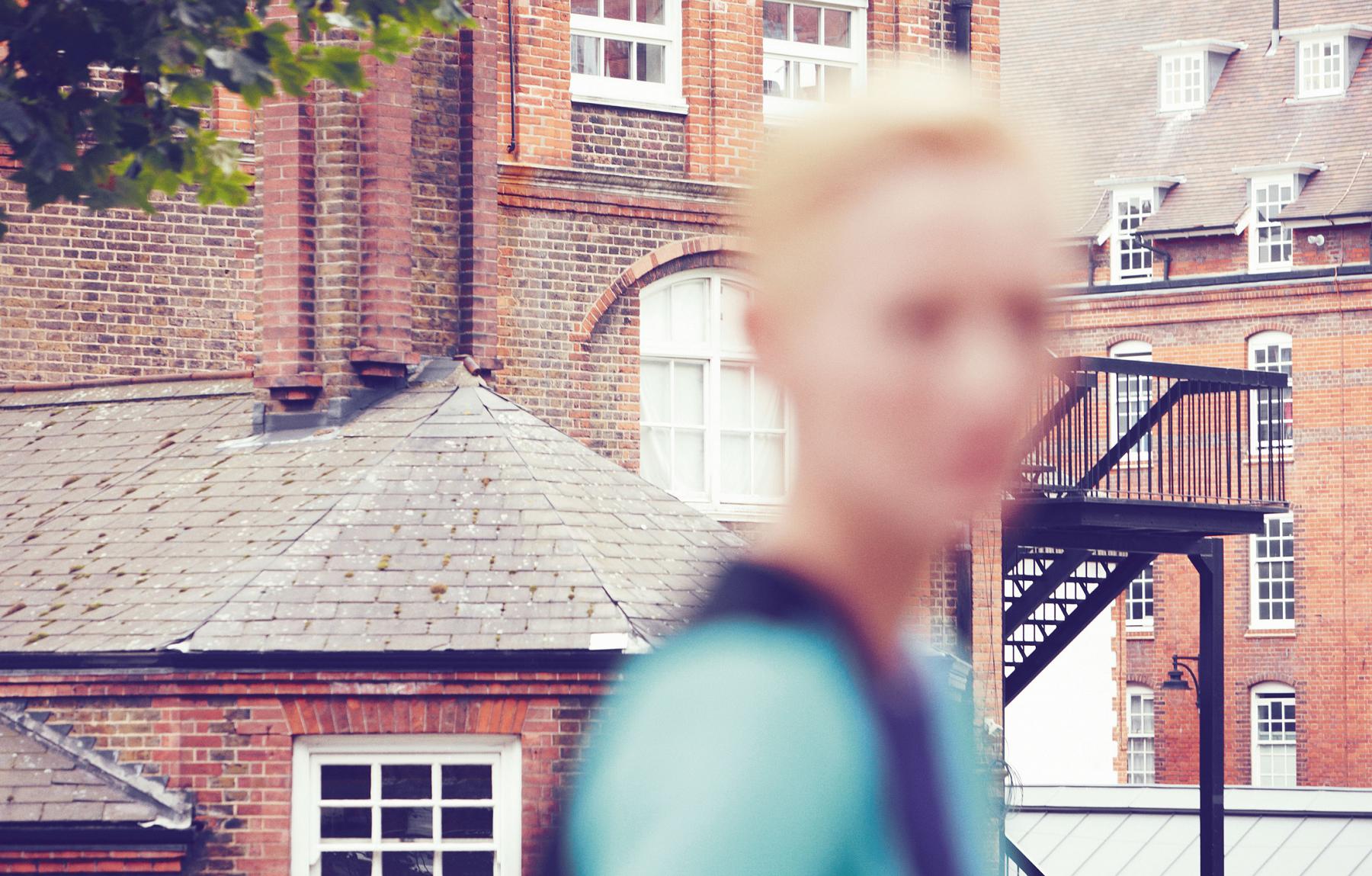
“I love actresses who’ve only been in one film. Every film I make, I want it to be my last.”
Our lunch reservation at the Cawdor Tavern has been cancelled, Tilda informs me, as she’s got something in the oven for me. I’d assumed she’d be more protective of her family home, and in the face of such openness, I feel compelled to come clean about an earlier visit to one of her other dwellings. Sitting at her huge kitchen table, eating her cottage pie with ketchup and home-baked bread, I admit I once gatecrashed a party at her flat in Paris. Having been assured by a PR friend that we were heading somewhere “low-key” one night during Fashion Week, we’d initially been mortified to find ourselves in the hallway of Tilda’s apartment near Odéon with a bunch of A-list fashion celebrities. Planning a swift exit, we’d snuck around the corner, only to find ourselves in the living room with our hostess, who’d taken over the DJ decks and was rocking out to ‘Les Fleurs’ by Minnie Riperton, hands aloft. I tell her we were so disarmed by the scene that we forgot our gaffe and spent at least two hours dancing exuberantly with her and her friends. “Ha!” she hoots, unperturbed. “I’m pleased you had a good time. You were in grrreat company.” Tilda’s keen to point out, however, that she doesn’t think fashion would play such a prominent part in her life had she not been approached. Often held up as a modern style icon, model-sized Tilda is cherished by the industry for attending high-profile events wearing its most progressive labels, Lanvin, Dior, Haider Ackermann, Viktor & Rolf and Pringle among them. “That world is very, very tight,” she says. “Everybody’s up against the same things, which is what I love about it. But my relationship with fashion is entirely my relationship with those particular people; I would be making it up as I go along if it weren’t for those friendships.”
Sandro arrives to make us some juice. In his upstairs studio, he compensates for the substantial air miles between him and most of his portrait subjects by using Skype’s online video conferencing for sittings. He’s painted many of his and Tilda’s friends from the house in Nairn – the fashion designer Haider Ackermann, the jewellery designer Waris Ahluwalia, the writer and producer Carlo Antonelli. I wonder aloud which of Tilda’s many collaborators are the couple’s real friends. “Interesting you ask,” she says, “because now the children are 14 and I’ve kind of caught up, I’ve started to look around for my friends more than ever. Very few of them live here, so I have to make a real effort to stay in contact. But one of the advantages of being here is that they come, and they stay, and we really get a chance to catch up. We don’t just have dinner in a restaurant and not see each other again for four months.” She turns to her softly spoken boyfriend. “What do you think?” He looks rather put on the spot. “What I would say about Tilda is that she’s the friendliest person in the world,” he says. “But there’s not much time to share.”
The house, though, a handsome Scottish Arts and Crafts home, is for sharing. Here Tilda has surrounded herself with souvenirs of significant people and places. The cream walls are filled with artwork: prints and paintings by Byrne; the framed lyrics of ‘People Have the Power’, signed by Patti Smith; a government-issue poster dating from the Second World War advising the public to ‘Eat greens daily for health.’ And all around are the personal touches of the easy house Tilda aspired to as a child: a giant wicker dog basket that accommodates all six spaniels, a cosy sitting room full of floral soft furnishings. There are Jamie Oliver and Gary Rhodes cookbooks next to tall jars of dry ingredients in the pantry. There are even pencil markings on the kitchen doorframe documenting the heights of her family and friends – a sort of graphic guest book, which confirms that Viktor Horsting of Viktor & Rolf measures the exact same number of centimetres as Brad Pitt: 182. At one point during lunch, I feel so relaxed that I catch myself unconsciously playing with one of the dogs under the table with my foot. Or so I thought. I look down to see that Tilda’s pet tortoise has crawled onto my sock.
Only the Diptyque Géranium Rosa candles in the entrance hall speak of another, more urban existence. I have a good look for career trophies – maybe some film poster alluding to a favourite project – but to no avail. I visit the bathroom, wondering whether I’ll find the Oscar statuette she said she’d give to her agent in her 2007 acceptance speech. But what I find instead is a framed health and safety certificate for the Ballerina Ballroom, signed by the Highlands’ environmental health officer, John Lee, in 2008. It’s good to know that Tilda triumphed in the battle of the driveway after all.
Two years ago, she had the chance to capture this atmosphere and put it in a bottle. The moment the French fragrance house État Libre d’Orange approached Tilda to work with it on a scent, she knew exactly what she needed: a homesickness potion. “So we started working out the individual smells of this house,” she says – “ginger, carrot, orange.” The finished eau de parfum is partly a self-portrait, too. “Lots of orange, because I’m a natural ginger. Pumpkin from my birthday month, November...”
Tilda offers me a bottle. Noticing the scent’s name, Like This, I can picture her standing in her kitchen, delivering that two-word brief to the parfumiers. Nothing could be simpler than collaborating with someone with such a facility for making herself understood. “What’s amazing is that it works,” Tilda says. “I put this on every day, and when I’m abroad, I feel like I’m here.”
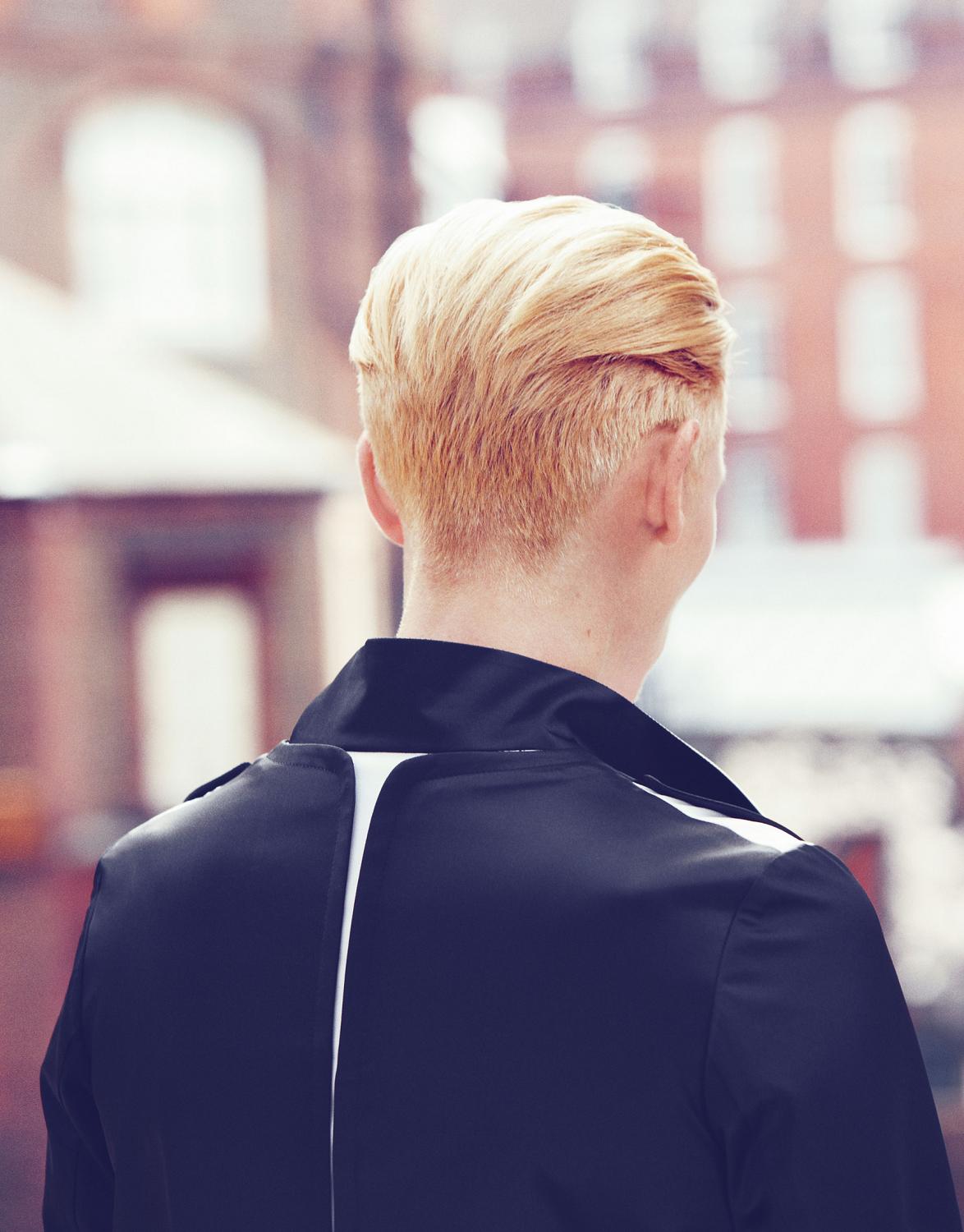
Tilda, who’s quite knowledgeable about horses and a proficient gambler, is wearing a silk short coat with contrast details by PRINGLE OF SCOTLAND.
Penny MartinPenny Martin is editor in chief of The Gentlewoman. Other long job titles she has held include chair of Fashion Imagery at London College of Fashion, editor in chief of SHOWstudio.com, curator of special collections at The National Women’s Library and curator at The National Museum of Photography,…read more Portraits by
Benjamin Alexander HusebyThe photographer Benjamin Alexander Huseby hails from Norway. He studied at the Chelsea of School of Art, London and currently lives in Berlin. Benjamin is a contributor to magazines such as Fantastic Man, Self-Service, both UK and US editions of Vogue, BUTT, Dazed and i-D and his work has featured in…read more Styling by
Jonathan KayeJonathan Kaye is fashion director of The Gentlewoman. A graduate of Central St. Martins' prestigious MA Fashion course (the good ones often are), Jonathan is one of the most industrious stylists in the business and thus operates on a “strictly no parties” basis. He has collaborated with photographers…read more
Hair: Antony Turner at Art Partner. Make-up: Petros Petrohilos at Streeters. Manicure: Anatole Rainey at Premier Hair & Make-up. Props styling: Robert Storey. Photographic assistance: Jeff Metal. Styling assistance: Max Ortega Govela. Production: Rosco Brady at Rosco Production.
This profile was originally published in The Gentlewoman n° 5, Spring & Summer 2012.